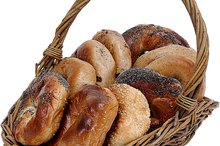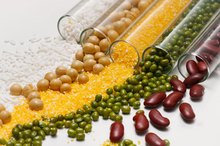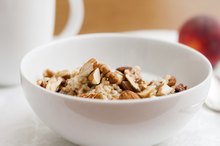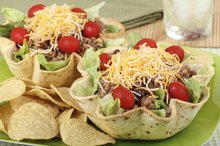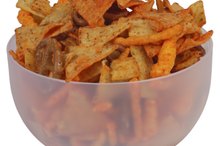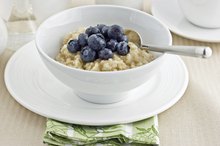Gluten Foods to Avoid for Hashimoto's
Individuals with Hashimoto's disease may need to avoid gluten foods because, just like celiac disease, Hashimoto's is a chronic autoimmune disorder. An autoimmune disorder is a condition where the body's immune system attacks its own tissues; in the case of Hashimoto's, the thyroid gland is affected. Gluten foods are not the cause of the disorder, but for some people they trigger an immune system response that results in tissue inflammation and destruction.
What is Gluten Sensitivity?
The authors of "Medical Surgical Nursing: Assessment and Management of Clinical Problems" explain that approximately 1 percent of the population have true celiac disease, but many more have gluten sensitivity 1. Gluten is a protein found in wheat, rye, oats and barley. When susceptible people ingest gluten, it becomes partially digested and releases other proteins and amino acids that the intestinal lining absorbs. Because these peptides cannot be digested, they trigger an inflammatory response in the intestine.
- The authors of "Medical Surgical Nursing: Assessment and Management of Clinical Problems" explain that approximately 1 percent of the population have true celiac disease, but many more have gluten sensitivity 1.
- When susceptible people ingest gluten, it becomes partially digested and releases other proteins and amino acids that the intestinal lining absorbs.
The Hashimoto's-Gluten Connection
Foods Containing Gluten & Gliadin Proteins
Learn More
Hashimoto's is an organ-specific autoimmune disorder. The affected person's immune system directs its attack primarily at the thyroid gland. However, people with Hashimoto's have a similar genetic predisposition to those with celiac disease. This connection was established in a research study published in 2007 in the "World Journal of Gastroentorology" and has been repeatedly supported through further studies. Patients with Hashimoto's should be screened for celiac disease and, early in the disease process, may benefit from following a gluten-free diet. Before adopting a gluten-free diet, you should be evaluated by your physician to establish the need for such a measure.
- Hashimoto's is an organ-specific autoimmune disorder.
- Patients with Hashimoto's should be screened for celiac disease and, early in the disease process, may benefit from following a gluten-free diet.
Foods to Avoid
Gluten, also referred to as a vegetable protein, is found in every flour product unless it is specifically made with a gluten-free product, such as rice flour, or labeled as gluten free. Although you can purchase gluten-free flour, oatmeal, and processed foods such as bagels and muffins, these products are expensive. Wheat, barley, oats, rye, flour and processed foods such as:
- pizza
- cookies
- crackers
- pies contain gluten
Although natural oats are gluten free, they are hard to find and often become contaminated with wheat, rye or barley during the milling process. Other foods to consider regarding their gluten content are pasta, dumplings and potato bread, which all contain gluten.
- Gluten, also referred to as a vegetable protein, is found in every flour product unless it is specifically made with a gluten-free product, such as rice flour, or labeled as gluten free.
- Other foods to consider regarding their gluten content are pasta, dumplings and potato bread, which all contain gluten.
Hidden Gluten
Health Benefits of Gluten
Learn More
Many products contain hidden gluten because it is used as a filler or binder. Read food and vitamin labels to search for gluten listed as vegetable protein, food starch, malt or graham. Malt is made from barley, so avoid malt alcohols and malt vinegar. Manufacturers do not have to list gluten or gluten-containing ingredients if used for packaging. So items you would not expect to find gluten in, such as spaghetti sauce or a chocolate bar, may indeed contain gluten. Because packaged and processed foods pose many questions as to whether or not they are gluten free, you may find it easier to make a lot of your own foods. You can make your own spaghetti sauce, breads and other baked goods at home using fresh produce and gluten-free flour or rice flour.
- Many products contain hidden gluten because it is used as a filler or binder.
- You can make your own spaghetti sauce, breads and other baked goods at home using fresh produce and gluten-free flour or rice flour.
Related Articles
References
- "Medical Surgical Nursing: Assessment and Management of Clinical Problems"; Sharon L. Lewis, PhD., et al.; 2011
- “World Journal of Gastroenterology”; Prevalence of Coeliac Disease in Patients with Autoimmune Thyroiditis in a Turkish Population; Sefa Guliter et al.; March 2007
- Celiac Disease Foundation. Sources of Gluten.
- U.S. Food & Drug Administration. Gluten and Food Labeling. Updated July 16, 2018.
- U.S. Food & Drug Administration. Proposed Rule for Gluten-Free Labeling of Fermented or Hydrolyzed Foods. Updated November 16, 2017.
- Gluten Intolerance Group of North America (GIG). GFCO Certification Scheme Manual Rev. 2020.1. Published 2020.
- National Celiac Association. GF Certification Seal Program. Updated August 2018.
- Beyond Celiac. Is Whiskey Gluten-Free?.
- Celiac Disease Foundation. Gluten-Free Foods.
Resources
Writer Bio
Patricia Nevins is a registered nurse with nearly 20 years of nursing experience. She obtained her Master of Science in nursing with a focus in education from the University of Phoenix. Nevins shares her passion for healthy living through her roles as educator, nursing consultant and writer.

